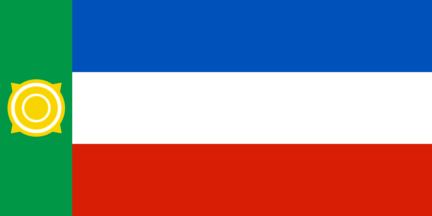 image by Tomislav Šipek, 15 December 2019
image by Tomislav Šipek, 15 December 2019
Last modified: 2022-12-31 by valentin poposki
Keywords: khakassia | sun: 4 rays | ethnic | stela | scytho-siberian art | tazmin | okunevo |
Links: FOTW homepage |
search |
disclaimer and copyright |
write us |
mirrors
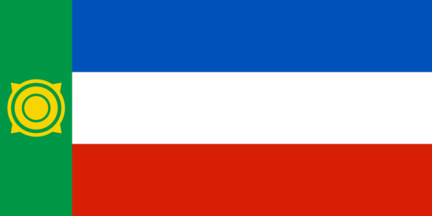 image by Tomislav Šipek, 15 December 2019
image by Tomislav Šipek, 15 December 2019
(Note: You need an Unicode-aware software and font to correctly view the Cyrillic text on this page. See here transliteration details).
Khakassia was one of the parts of the
Krasnoyarsk region two years ago.
Now it is not.
Larisa V. Voloshenko, 19 Mar 1998
As of 25 September 2003 the flag of the Republic of Khakassia has
its horizontal stripes [changed and] arranged
blue/white/red. The green vertical hoist stripe with the solar symbol
remains. Authority: a report from the Regional Journalism Club, cited at
Regions.RU.
John Ayer, 26 Sep 2003
I suppose the hoist stripe derives from the Khakass
ethnical flag, as it shows the same device and colors.
António Martins, 01 Jun 2001
I believe this change is due to a recent
recommendation from the Presidential Heraldry Cabinet calling for
non-use of the national
flag pattern in subnational vexillology and heraldry (reserving for
flags and arms of federal institutions, I guess).
António Martins, 29 Dec 2003
According to the information on
Victor’s site, an
exception was made in the case of Khakassia because their flag pre-dated the
legislation forbidding use of the
National Flag on any regional flags, but the Parliament
of Khakassia introduced the change anyway.
Christopher Southworth, 29 Sep 2003
Sources of images:
http://oldgazeta19.ru/news/57078
http://moyaokruga.ru/shiravest/Articles.aspx?articleId=147562
http://www.o-spide.ru/news/test-na-vich-ekspediciya-iii-vserossiiskaya-akciya-minzdrava-rossii-po-besplatnomu-anonimnomu-ekspress-testirovaniyu-na-vich-infekciyu-zavershilas-v-khakasii
http://www.o-spide.ru/news/test-na-vich-ekspediciya-iii-vserossiiskaya-akciya-minzdrava-rossii-po-besplatnomu-anonimnomu-ekspress-testirovaniyu-na-vich-infekciyu-zavershilas-v-khakasii
Tomislav Šipek, 15 December 2019
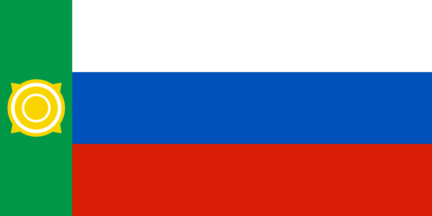 image by Tomislav Šipek, 15 December 2019
image by Tomislav Šipek, 15 December 2019
The Khakassian flag was based on the Russian
tricolour of white-blue-red. At the hoist is a green vertical stripe
with a circular emblem (which also appears on the coat of arms).
Stuart Notholt, 26 Sep 1995
I suppose the hoist stripe derives from the
Khakass ethnical flag, as
it shows the same device and colors. The meaning would also be obvious,
since the republic’s flag adds an extensive Russian
tricolor to the Khakass emblem.
António Martins, 01 Jun 2001
In 1993 the sun was changed to yellow, but
lined white, not green [as in ethnical flag].
I saw it myself last summer when I was in Khakasiya: there are two white
circles inside.
Carlo Scopelliti, 15 Aug 2000
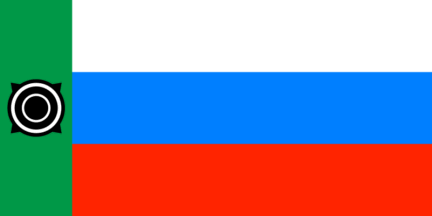 image by Tomislav Šipek, 15 December 2019
image by Tomislav Šipek, 15 December 2019
On June 6th, 1992, the Flag Law was adopted by the Supreme Soviet of
the Republic. The flag was: three horizontal stripes — white, blue,
red; black-white solar sign on the green vertical stripe near the hoist. On
December 23rd, 1993 the Law No 29 changed the colours of
the solar sign from black and white to golden and white.
Victor Lomantsov, 23 Apr 2000 and 16 Aug 2000
The official web site of the Republic of Khakassia still displays
the black-white sun.
Jan Zrzavy, 22 Apr 2000
This flag, with medium blue central stripe,
is listed under number 121 at the chart Flags
of Aspirant Peoples [eba94] as:
«Khakassia (Khakass Turks) - South Siberia».
Ivan Sache, 15 Sep 1999
 image by Tomislav Šipek, 15 December 2019
image by Tomislav Šipek, 15 December 2019
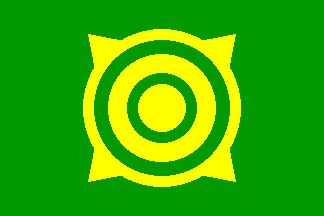 image by António Martins and Jaume Ollé, 24 Apr 2000
image by António Martins and Jaume Ollé, 24 Apr 2000
This is the National Flag of the Khakassian People, i.e.
ethnically the Khakass. The symbol is yellow on green and the 2nd and
4th rings from the center are green.
Timur Davletov, 06 Apr 2000
The field is green because in the Middle Ages that people had green flags (although they were not and have never been Muslims). The Arab writer Abu Dulaf, who traveled extensively throughout Central Asia in the 9th century wrote the following statement about the Kyrgyz people (the Khakass of our days originate from that people and other ethnic groups):
They have a temple for worship services and a cane, by means of which they write…
Their flags are of green color.(From Yu. S. Khudyakov’s article “Shamanism and world religions among the Kyrgyz people in the Middle Ages”, Traditional beliefs and way of life of the peoples of Siberia (XIX century - beginning of the XX century. Nauka: Novosibirsk, 1987; the translation is mine)
Green is also a traditional color in Siberia, associated with forests.
Carlo Scopelliti, 14 Jan 2003
As regards the sun, it is not a Khakasian symbol: it was recently adopted. Actually, this sun-symbol is to be found on the stone stelae of the prehistoric Tazmin civilization (some historians call it Okunevo civilization, but since there is another, different civilization called Okunevo, I think that Tazmin is better). The Tazmin civilization was simply located in the region where Khakasiya is now: the Khakasian people (which is of Turkish stock, mixed with local tribes) appeared much later. These stelae are very famous in Khakasiya: they call them kamennye baby in Russian (stone women). The sun is divided into three parts because it travels along its orbit in the sky, shines above the earth and visits the underworld during the night.
The Khakasian people, before being converted into Orthodox Christianity, followed a shamanistic religion and used to make offerings before those stelae, belonging to a long-forgotten civilization which was not theirs. There is a shamanistic revival going on now, and the people have never really abandoned those practices: hence the importance of the stelae to them.
The sun-symbol is repeated on the emblem of the Khakasiya Republic, along with the sleeping snow-panther (spâxiĭ bars | спящий барс in Russian), a symbol found on a wonderful object of Scytho-Syberian art in a burying mound of the Altay Region in Southern Siberia (although Altay is not Khakasiya, this art, which is a variant of Scythian art, was widespread all over Siberia).
Carlo Scopelliti, 15 Aug 2000
.gif) image by Željko Heimer and António Martins, 24 Dec 2005
image by Željko Heimer and António Martins, 24 Dec 2005
The new arms are in use since 1.1.2002 (adopted in
2001). Author of drawing Alexander Kotozhekov.
Victor Lomantsov, 07 Mar 2002